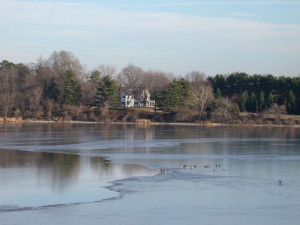Watershed Restoration Action Strategy (WRAS)
In 1998, the Corsica River was designated as “impaired” under the Clean Water Act. In 2002, work began on developing a watershed restoration action strategy (WRAS) for cleaning it up. That work continues today.
After the impairment designation, with the assistance of the Department of Natural Resources, and under a grant from EPA, a watershed assessment in a 100-mile stream corridor of the River and associated streams and natural resources found excess nitrogen and phosphorus, fecal coliform bacteria, excessive sediment, toxic materials including PCBs, and poor or very poor conditions for biological organizations. (Results of the study, published in October 2003 can be found at https://dnr.maryland.gov/waters/Documents/WRAS/cr_char.pdf.) The Corsica was deemed as needing restoration in four areas: sediments, nutrients, PCBs, and bacteria. Legally required limits, known as Total Maximum Daily Limits (TMDLs) were established for nitrogen and phosphorus.
Under the Town of Centreville’s leadership, a watershed restoration action strategy (WRAS) was developed in September 2004 and a stakeholders group was created to monitor and assist in its implementation.
The WRAS was completed in September 2004 by a stakeholders group consisting of representatives from Queen Anne’s Soil Conservation District, the USDA-NRCS, the Chester River Association, the Eastern Shore Land Conservancy, the Queen Anne’s County Planning Commission, Queen Anne’s County Planning and Zoning, and Maryland Department of Natural Resources. The University of Maryland, the Alliance for the Chesapeake Bay, the Queen Anne’s County Health Department and local builders/developers also participated. The stakeholder group met 11 times over a two year period.
The Goal of the WRAS was to remove the Corsica River from the 303(d) list of impaired waterways. This goal was to be accomplished by putting in place the following 13 implementation strategies.
- Increase Nutrient Uptake: Install 3,000 acres of cover crops to reduce nutrients by 21,000 lbs of nitrogen (N) and 570 lbs of phosphorus (P).
- Install Agricultural Buffers: Add 100 acres of 100-foot wide nutrient and sediment reducing buffers 100 ft wide to reduce 9,188 lbs (N) and 792 lbs (P).
- Manage Whole Farm and Horse Pastures: Improve manure storage and treatment and stormwater entrapment on farms and horse pastures ten acres or less. Install demonstration projects on fifty acres using five farms of 10 acres each. The nutrient reduction is 15,977 lbs of (N) and 1,944lbs of (P).
- Reduce Household Pollution: Implement an outreach program for the Town of Centreville to reduce the use of excess fertilizer on lawns and properly manage pet waste. The total loading reduction goal is 17% for (N) and 22% for (P). Progress will be monitored by a phone survey.
- Monitor Main Stem Water Quality: The Chester River Association (now ShoreRivers), Department of Natural Resources, and University of Maryland will work together to develop a water quality monitoring program.
- Increase Submerged Aquatic Vegetation: Plant one acre of submerged aquatic vegetation (SAV). The measure of success will be the square footage of SAV planted in the spring compared to the amount of SAV surviving into the fall.
- Centreville Low Impact Development Ordinance and Stormwater Manual: The town of Centreville will produce a water quality ordinance and water quality design manual to supercede the existing Queen Anne County Stormwater management ordinance. This low impact design is modeled after Huntersville , North Carolina’s low impact development ordinance. Design and construction of regional urban stormwater management facilities at Millstream and Gravel Run. The goal reduction is 33% for (N) and 46% for (P).
- Bay Friendly Landscaping: Citizens will learn how to reduce pollution by using native plants, which require fewer chemicals, and installing rain gardens. A public landscaping demonstration project will restore an environmentally impaired site to use as an example. Success is measured by the number of citizens that participate. Centreville town will donate public lands for the project at the Millstream and Gravel Run. The Residential Buffer Planting and Conservation Landscaping component will Identify and prioritize residential areas in need of increased buffers . Workshops for property owners will be used to encourage resident participation.
- Provide Incentives for Easements: Conservation easements will be used for environmentally sensitive areas in the Corsica watershed.
- Create Non-Agricultural Wetlands: Two wetland restoration sites will be identified with the intention to engage 100 citizens in marsh plantings and restoration. The anticipated pollution reduction is 42% (N) and 52% (P).
- Retrofit Septic Systems: Septic systems that lie within 300 feet of the critical areas will be upgraded. The focus will be within a 300-foot buffer of perennial streams or tide water.
- Create Ecoteams – The Chester River Association (now ShoreRivers) will lead an effort to recruit urban and suburban homeowners to adopt their local waterways with monitoring and stream clean up projects. Participants will learn best management practices (BMPs) for river protection and restoration. There will be support groups and volunteer team leaders. The phosphorus reduction per household is 10 lbs and assume 50 household participation. This is a total reduction of 500 lbs of P.
- Reduce Turbidity Reduction: Reintroduction oyster reef ecosystems to assist with turbidity reduction.
These specific strategies and measures have been modified over time but the major tenets remain in place.
Early efforts were slow to catch on
A Bay Journal article from March 2009 pointed out some of the difficulties in getting changes in residents’ behavior in its article “Corsica Cleanup Learns That More Than Money Is Needed to Succeed.”
“What the Corsica needs is more public participation,” said John McCoy, director of the Maryland Department of Natural Resources Ecosystem Restoration Center, who coordinated state activities in the watershed and was quoted in the article. “What it takes to get that, we haven’t figured out yet.” He and others said many watershed residents had not bought into restoration efforts, according to the article. In fact, many appeared to be unaware of the targeted effort, despite mailings that had gone to every household, information packets sent to new residents and other outreach efforts.
“I’ve gone out and given dozens of lectures to local citizens groups, and usually what I find out is that these people are really unaware of what is going on,” said Jim Malaro in the article who was a previous president of the conservancy. “I’ve had people ask me, ‘Where is the river?’ That is telling.”
Several years into the restoration effort, projects on public lands, such as wetlands restoration, and institutional decisions made by town and county agencies set the stage for individual landowners to also take action. Work on the Town Wharf in Centreville expanded access to the River. On private lands, rain gardens were the most popular efforts, in large part because of the ease of installation and cost sharing requirements. Installing upgraded septic systems, a more complicated process, lagged significantly. On farmland in the watershed, only about a third of the 6,000 acres of cover crops called for in the plan had been planted according to the 2009 article. Only about a tenth of the goal of enrolling 100 acres in the Conservation Reserve Enhancement Program, which pays farmers to take environmentally sensitive lands out of production and restore them, had been met. Efforts to implement horse pasture management was also lagging.
Getting sufficient participation in funded programs was only part of the challenge. Even under lands planted with cover crops, in which sharp decreases in nitrogen had been recorded, results in water quality lagged because it takes years for these improvements to work their way through groundwater.
“Cleaning up the Corsica takes a lot of patience,” said Frank DiGalleonardo, currently Board President, as the Conservancy continued with its education, outreach, and programmatic efforts.
Has any progress been made?
The answer is yes. A progress report, covering the period of 2005-2011 and issued in 2012 found a slight improvement in River health. (For the full report, see https://dnr.maryland.gov/ccs/Publication/Corsica_report.pdf). In 2019, MDE issued a follow up report, conducted by staff of the Interstate Commission on the Potomac River Basin, which had even better news, showing a significant and improving nutrient reductions in the three tributaries of the Corsica River. Both the long term (2006-2017) and short term (2012-2018) trends in total nitrogen are significant and decreasing for all three. Long term trends in total phosphorus concentrations are significant and downwards for all three as well. However, only the Gravel Run tributary showed a significant short term difference in phosphorus. (For the full report, see https://www.potomacriver.org/wp-content/uploads/2019/08/ICP19-2_Wallace.pdf
The results indicate that the many Best Management Practices (BMPs) that have been installed throughout the Corsica River Watershed during its ecosystem-wide restoration appear to be having significant and largely increasing effect. .
Today, the Corsica River Implementors Committee meets monthly to continue work on improving the health of the Corsica River and its surrounding ecosystem. It consists of representatives from state, county, and town agencies, scientists, and local non-profit groups. These include Maryland’s Departments ot the Environment (MDE), Natural Resources (DNR), Planning, and Agriculture (MDA), Queen Anne’s County Department of Public Works & Planning and Zoning and the Soil Conservation District, the Corsica River Conservancy, ShoreRivers, the Master Gardeners Program, and the University of Maryland.

